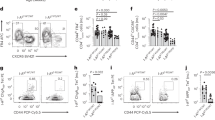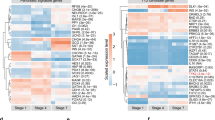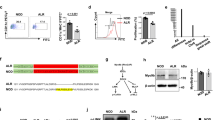Abstract
Type 1 diabetes or insulin-dependent diabetes mellitus (IDDM) is due to autoimmune destruction of pancreatic β-cells. Genetic susceptibility to IDDM is encoded by several loci, one of which (IDDM2) maps to a variable number of tandem repeats (VNTR) minisatellite, upstream of the insulin gene (INS)1–5. The short class I VNTR alleles (26–63 repeats) predispose to IDDM, while class III alleles (140–210 repeats) have a dominant protective effect1–6. We have reported that, in human adult4'6 and fetal7 pancreas in vivo, class III alleles are associated with marginally lower INS mRNA levels than class I, suggesting transcriptional effects of the VNTR. These may be related to type 1 diabetes pathogenesis, as insulin is the only known β-cell specific IDDM autoantigen. In search of a more plausible mechanism for the dominant effect of class III alleles, we analysed expression of insulin in human fetal thymus, a critical site for tolerance induction to self proteins. Insulin was detected in all thymus tissues examined and class III VNTR alleles were associated with 2- to 3-fold higher INS mRNA levels than class I. We therefore propose higher levels of thymic INS expression, facilitating immune tolerance induction, as a mechanism for the dominant protective effect of class III alleles.
This is a preview of subscription content, access via your institution
Access options
Subscribe to this journal
Receive 12 print issues and online access
$209.00 per year
only $17.42 per issue
Buy this article
- Purchase on Springer Link
- Instant access to full article PDF
Prices may be subject to local taxes which are calculated during checkout
Similar content being viewed by others
References
Julier, C. et al. lnsulin-IGF2 region on chromosome 11p encodes a gene implicated in HLA-DR4-dependent diabetes susceptibility. Nature 354, 155–159 (1991).
Lucassen, A.M. et al. Susceptibility to insulin dependent diabetes mellitus maps to a 4.1-kb segment of DNA spanning the insulin gene and associated VNTR. Nature Genet. 4, 305–310 (1993).
Owerbach, D. & Gabbay, K.H. Localization of a type I diabetes susceptibility locus to the variable tandem repeat region flanking the insulin gene. Diabetes 42, 1708–1714 (1993).
Bennett, S.T. et al. Susceptibility to human type 1 diabetes at IDDM2 is determined by tandem repeat variation at the insulin gene minisatellite locus. Nature Genet. 9 284–292 (1995).
Undlien, D.E. et al. Insulin gene region-encoded susceptibility to IDDM maps upstream of the insulin gene. Diabetes 44, 620–625 (1995).
Bennett. ST et al. IDDM2-VNTR-encoded susceptibility to type 1 diabetes; dominant protection and parental transmission of alleles of the insulin gene-linked minisatellite locus. J. Autoimmun. 9, 415–421 (1996).
Vafiadis, P. et al. Imprinted and genotype-specific expression of genes at the IDDM2 locus in pancreas and leucocytes. J. Autoimmun. 9, 397–403 (1996).
Jolicoeur, C. Hanahan, D. & Smith, K.M. T-cell tolerance toward a transgenic beta-cell antigen and transcription of endogenous pancreatic genes in thymus. Proc. Natl. Acad. ed. USA 91, 6707–711 (1994).
Pugliese, A. et al. Transcription levels of human insulin in the thymus correlate with allelic variation at the IDDM2 1 diabetes.Nature Genet. 15, 293–297 (1997).
Heath, W.R. et al. Autoimmune diabetes as a consequence of locally produced interleukin-2. Nature 359, 547–549 (1992).
Miller, J.F. Morahan, G. & Allison, J. Extrathymic acquisition of tolerance by T lymphocytes. Cold Spring Harbor Symp. Quant. Biol. 54, 807–813 (1989).
Giddings, S.J. King, C.D. Harman, K.W. Flood, J.F. & Carnaghi, L.R. Allele-specific inactivation of insulin 1 and 2, in the mouse yolk sac, indicates imprinting. Nature Genet. 6, 310–313 (1994).
Pugliese, A. Awdeh, Z.L. Alper, C.A. Jackson, R.A. & Eisenbarth, G.S. The paternally inherited insulin gene B allele (1, 428 Fokl site) confers protection from insulin-dependent diabetes in families. Autoimmun. 7, 687–694 (1994).
Polychronakos, C. Kukuvitis, A. Giannoukakis, N. & Colle, E. Parental imprinting effect at the INS-IGF2 diabetes susceptibility locus. Diabetologia 38, 715–719 (1995).
Bui, M.M. et al. Paternally transmitted IDDM2 influences diabetes susceptibility despite biallelic expression of the insulin gene in human pancreas. J. Autoimmun. 9, 97–103 (1996).
Xu, Y. Goodyer, C.G. Deal, C. & Polychronakos, C. Functional polymorphism in the parental imprinting of the human IGF2R gene. Biochem. Biophys. Res. Commun. 197 747–754 (1993).
Smrzka, O.W. et al. Conservation of a maternal-specific methylation signal at the human IGF2R locus. Hum. Mol. Genet. 4, 1945–1952 (1995).
Jinno, Y. et al. Mosaic and polymorphic imprinting of the WT1 gene in humans. Nature Genet. 6, 305–309 (1994).
Saoudi, A. Seddon, B. Heath, V. Fowell, D. & Mason, D. The physiological role of regulatory T cells in the prevention of autoimmunity the function of the thymus in the generation of the regulatory T cell subset. Immunol. Rev. 149, 195–216 (1996).
Batanero, E. et al. The neural and neuro-endocrine component of the human thymus. II. Hormone immunoreactivity. Brain Behav. Immun. 6, 249–264 (1992).
Antonia, S.J. Geiger, T. Miller, J. & Flavell, R.A. Mechanisms of immune tolerance induction through the thymic expression of a peripheral tissue-specific protein. Intl. Immunol. 7, 715–725 (1995).
Rudy, G. et al. Similar peptides from two beta cell autoantigens, proinsulin and glutamic acid decarboxylase, stimulate T cells of individuals at risk for insulin-dependent diabetes. Mol. Med. 1, 625–633 (1995).
Keilacker, H. Rjasanowski, I. Besch, W. & Kohnert, K.D. Autoantibodies to insulin and to proinsulin in type 1 diabetic patients and in at-risk probands differentiate only little between both antigens. Hormone Metab. Res. 27, 90–94 (1995).
Griffin, A.C. Zhao, W. Wegmann, K.W. & Hickey, W.F. Experimental autoimmune insulitis. Induction by T lymphocytes specific for a peptide of proinsulin. Am. J. Path. 147, 845–857 (1995).
Berg, H. Walter, M. Mauch, L. Seissler, J. & Northemann, W. Recombinant human preproinsulin. Expression, purification and reaction with insulin autoantibodies in sera from patients with insulin-dependent diabetes mellitus. J. Immunol. Meth. 164, 221–231 ( 1993).
von Herrath, M.G. Dockter, J. Nerenberg, M. Gairin, J.E. & Oldstone, M.B. Thymic selection and adaptability of cytotoxic T lymphocyte responses in transgenic mice expressing a viral protein in the thymus. Exp. Med. 180, 1901–1910 (1994).
Posselt, A.M. Barker, C.F. Friedman, A.L. & Naji, A. Prevention of autoimmune diabetes in the BB rat by intrathymic islet transplantation at birth. Science 256, 1321–1324 (1992).
Ashton-Rickardt, P.G. et al. Evidence for a differential avidity model of T cell selection in the thymus. Cell 76, 651–663 (1994).
Sebzda, E. et al. Positive and negative thymocyte selection induced by different concentrations of a single peptide. Science 263, 1615–1618 (1994).
Wegemann, D.R. Norbury-Glaser, M. & Daniel, D. Insulin-specific T cells are a predominant component of islet infiltrates in pre-diabetic NOD mice. Euro. J. Immunol. 24, 1853–1857 (1994).
Atkinson, M.A. Maclaren, N.K. & Luchetta, R. Insulitis and diabetes in NOD mice reduced by prophylactic insulin therapy. Diabetes 39, 933–937 (1990).
Keller, R.J. Eisenbarth, G.S. & Jackson, R.A. Insulin prophylaxis in individuals at high risk of type I diabetes. Lancet 341, 927–928 (1993).
Lucassen, A.M. et al. Regulation of insulin gene expression by the IDDM associated, insulin locus haplotype. Hum. Molec. Genet. 4, 501–506 (1995).
Owerbach, D. & Gabbay, K.H. The search for IDDM susceptibility genes. Diabetes 45, 544–551 (1996).
Kennedy, G. German, M.S. & Rutter, W.J. The minisatellite in the diabetes susceptibility locus IDDM2 regulates insulin transcription. Nature Genet. 9, 293–298 (1995).
McGinnis, R.E. & Spielman, R.S. Insulin gene 5′ flanking polymorphism. Diabetes 44, 1296–1302 ( 1995).
Denny, P. et al. Mapping of the Insulin-Dependent Diabetes locus, Idd3, to a 0.35 cM interval containing the Interleukin-2 gene. Diabetes (in the press).
Author information
Authors and Affiliations
Rights and permissions
About this article
Cite this article
Vafiadis, P., Bennett, S., Todd, J. et al. Insulin expression in human thymus is modulated by INS VNTR alleles at the IDDM2 locus. Nat Genet 15, 289–292 (1997). https://doi.org/10.1038/ng0397-289
Received:
Accepted:
Issue Date:
DOI: https://doi.org/10.1038/ng0397-289
This article is cited by
-
Expression of proinflammatory cytokines and proinsulin by bone marrow-derived cells for fracture healing in long-term diabetic mice
BMC Musculoskeletal Disorders (2023)
-
Genetics of ANCA-associated vasculitis: role in pathogenesis, classification and management
Nature Reviews Rheumatology (2022)
-
Diabetes: discovery of insulin, genetic, epigenetic and viral infection mediated regulation
The Nucleus (2022)
-
Variable number tandem repeats mediate the expression of proximal genes
Nature Communications (2021)
-
100 years of insulin: celebrating the past, present and future of diabetes therapy
Nature Medicine (2021)



